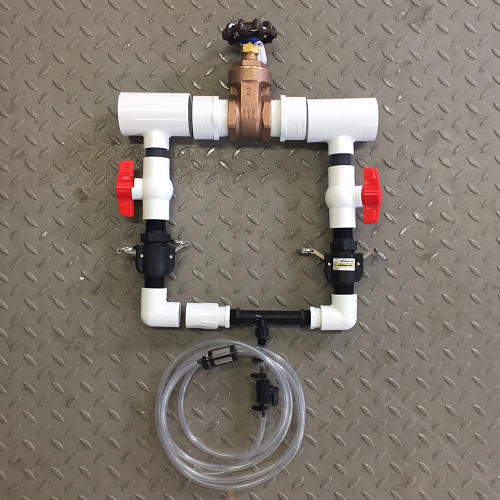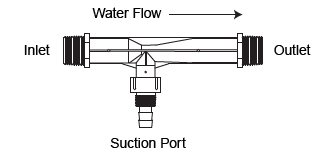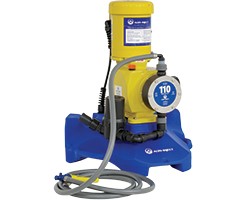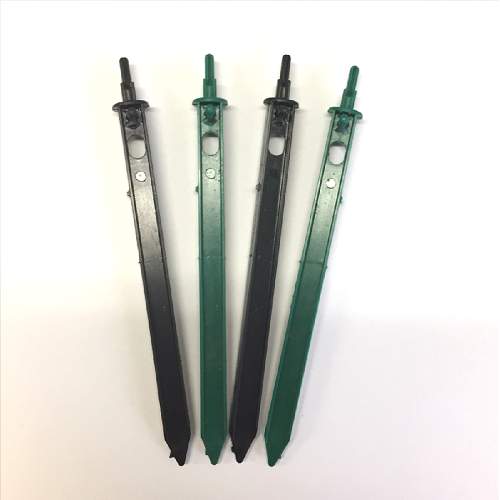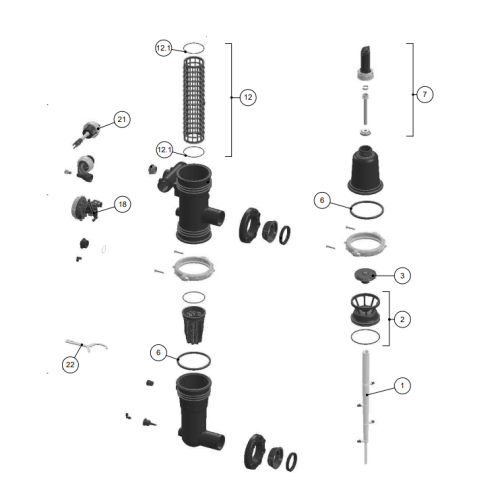Venturi Fertilizer Injector Assembly for 1 1/2″, 2″, 3″ or 4″ Line. Please call us for additional sizes and/or options.
A Venturi Fertilizer Injector Assembly is a device used in irrigation systems to introduce liquid fertilizers, pesticides, or other water-soluble solutions into the irrigation water. It operates on the Venturi effect, where a reduction in water pressure creates suction, allowing the injector to draw the fertilizer solution into the irrigation line without requiring an external power source.
Key Features:
- Venturi Injector Mechanism:
- Based on the Venturi principle, the injector creates a pressure differential within the water flow, generating suction to pull fertilizer or additives into the system.
- Efficiently mixes the solution with the irrigation water for even distribution.
- Complete Assembly:
- Typically includes a Venturi injector, a filter to protect against debris, a suction line for drawing the fertilizer, and control valves to regulate water flow and solution injection rates.
- Some assemblies may also include flow meters or pressure gauges for precision control.
- Durable Construction:
- Made from corrosion-resistant materials like plastic, brass, or stainless steel to withstand exposure to chemicals and harsh irrigation environments.
- Compatibility:
- Works with various irrigation systems, including drip, sprinkler, and pivot systems.
- Compatible with most water-soluble fertilizers and liquid additives.
- Energy-Free Operation:
- Requires no electricity or additional power sources, relying solely on the water pressure in the system.
How It Works:
- Water Flow:
- Pressurized water enters the Venturi injector, creating a constriction that reduces pressure and increases velocity.
- Suction:
- The pressure drop generates suction, drawing the fertilizer or solution through the suction line.
- Mixing:
- The solution is mixed with the water in the injector and carried through the irrigation system.
- Delivery:
- Nutrient-enriched water is distributed to plants via the irrigation network.
Benefits:
- Efficient Fertilizer Delivery:
- Ensures nutrients are delivered directly to the plant root zone, enhancing absorption and minimizing waste.
- Cost-Effective:
- Operates without the need for pumps or external power, reducing operational costs.
- Uniform Distribution:
- Provides consistent and even mixing of fertilizer with irrigation water for balanced plant growth.
- Simple and Reliable:
- Easy to install, operate, and maintain, with few moving parts to break or wear out.
- Water and Nutrient Conservation:
- Optimizes resource use and reduces environmental impact by preventing over-fertilization and runoff.
Common Applications:
- Drip Irrigation:
- Ideal for delivering precise nutrients directly to plant roots.
- Greenhouses:
- Supplies exact formulations of fertilizers and additives for controlled plant growth.
- Agricultural Crops:
- Supports even fertilization over large fields, improving yields.
- Horticulture and Landscaping:
- Feeds plants, lawns, and ornamental gardens efficiently.
Differences Between a Venturi Injector and a Venturi Fertilizer Injector Assembly:
- The Venturi Injector is the core device, while the Venturi Fertilizer Injector Assembly includes additional components such as filters, valves, and suction lines for a complete, ready-to-use system.
In summary, a Venturi Fertilizer Injector Assembly is a practical, energy-efficient tool for integrating liquid fertilizers and additives into irrigation systems. Its simplicity, cost-effectiveness, and precise nutrient delivery make it invaluable for modern agriculture, landscaping, and greenhouse operations.


